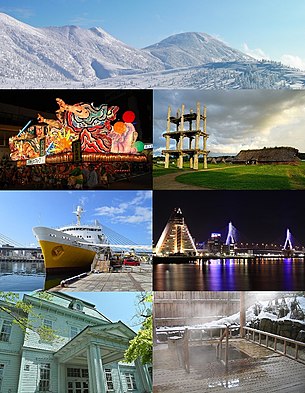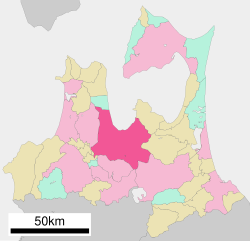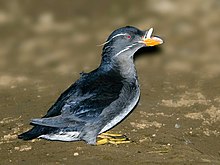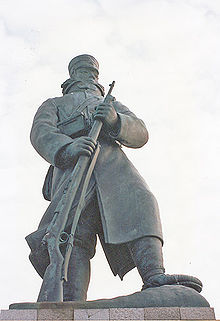Aomori
Aomori
Thanh sâm thị | |
|---|---|
| Aomori City | |
 From top to bottom, left to right: TheHakkōda Mountains,Aomori Nebuta Matsuri,Sannai-Maruyama Site,Seikan FerryMemorial ShipHakkōda Maru,the waterfront of Aomori as seen fromAomori Bay,theAomori City Forestry Museum,andAsamushi Onsen | |
 Location of Aomori in Aomori Prefecture | |
 | |
| Coordinates:40°49′22″N140°44′49″E/ 40.82278°N 140.74694°E | |
| Country | |
| Region | Tōhoku |
| Prefecture | |
| Utō-mura | ? |
| Aomori-mura | 1626 |
| Aomori-machi | 1 April 1889 |
| Aomori-shi | 1 April 1898 |
| Government | |
| • Mayor | Hideki Nishi(since June 2023) |
| Area | |
| •Core city | 824.61 km2(318.38 sq mi) |
| Elevation | 0 to 1,584 m (0 to 5,197 ft) |
| Population (1 August 2023) | |
| •Core city | 264,945 |
| • Density | 320/km2(830/sq mi) |
| •Metro | 310,640 |
| Demonym | Aomorian |
| Time zone | UTC+09:00(JST) |
| Area code | 02201-2 |
| Phone number | 017-734-1111 |
| Address | 1-22-5 Chūō, Aomori-shi, Aomori-ken |
| Expressways | |
| Website | Official website |
| Symbols | |
| Bird | Ural owl |
| Flower | Rosa rugosa |
| Insect | Firefly |
| Tree | Maries' fir |


Aomori(Japanese:Thanh sâm,Hepburn:Aomori,IPA:[aoꜜmoɾi];lit."Blue Forest" ),officiallyAomori City(Thanh sâm thị,Aomori-shi), is the capitalcityofAomori Prefecture,in theTōhoku regionofJapan.As of 1 August 2023[update],the city had an estimated population of 264,945 in 136,781 households,[1]and a population density of 321 people per square kilometer spread over the city's total area of 824.61 km2(318.38 sq mi). Aomori is one of Japan's 62core citiesand the core of theAomori metropolitan area.[2]
Geography
[edit]Aomori is located in central Aomori Prefecture, the northernmost prefecture ofHonshu.It is located in the northeastern part of the Tsugaru region, which refers to the western half of the prefecture, and is centered on Aomori Plain, facing Aomori Bay, a branch bay ofMutsu Bay,to the north, and theHakkōdaand Higashidake Mountains, which are the northern end of theŌu Mountainsto the south to the east. Among other smaller rivers, the city has two large rivers flowing through it, theKomagome Riverand its tributary, the Arakawa River. Parts of the city in the southeast are within the borders ofTowada-Hachimantai National Parkand is a tourist destination throughout the four seasons. In the northeast isAsamushi-Natsudomari Prefectural Natural Park.There are manyhot springsin the city, includingSukayu Onsenat the foot of Mt. Hakkōda andAsamushi Onsenon the coast.
Surrounding municipalities
[edit]Climate
[edit]Like most of the Tōhoku region, Aomori has a humid temperate climate with warm summers, and cold, though not extreme, winters. The city has a cold,humid continental climate(KöppenDfa) characterized by warm, short summers and long, cold winters with heavy snowfall. The average annual temperature in Aomori is 10.7 °C (51.3 °F). The average annual rainfall is 1,285 mm (50.6 in) with September as the wettest month. The temperatures are highest on average in August, at around 23.5 °C (74.3 °F), and lowest in January, at around −2.1 °C (28.2 °F).[3]
Aomori and the surrounding areas are known for having theheaviest snowfallin the world.[4]In February 1945, the city recorded a maximum snow cover of 209 cm (82 in), but the record low of −24.7 °C (−12 °F) was recorded 14 years earlier. In contrast,Sapporo's heaviest snowfall which occurred in 1939 was 164 cm (65 in), andWakkanaiwhich is located further north has recorded similar maxima. The particularly heavy snow is caused by several winds that collide around the city and make the air rise and cool, resulting in quick, thick cloud formation followed by intenseprecipitation.
In summer, a cool wind called "Yamase" often blows from the east, which sometimes results in abnormally cool weather and poor harvests. Additionally, thick fogs from theOyashio Currentare often observed in mountainous areas in the summer. Due to this fog, flights toAomori Airportare often cancelled.[5]
| Climate data for Aomori (1991−2020 normals, extremes 1882−present) | |||||||||||||
|---|---|---|---|---|---|---|---|---|---|---|---|---|---|
| Month | Jan | Feb | Mar | Apr | May | Jun | Jul | Aug | Sep | Oct | Nov | Dec | Year |
| Record high °C (°F) | 13.5 (56.3) |
19.4 (66.9) |
21.4 (70.5) |
28.3 (82.9) |
33.6 (92.5) |
33.5 (92.3) |
35.9 (96.6) |
36.7 (98.1) |
36.1 (97.0) |
30.5 (86.9) |
24.1 (75.4) |
21.1 (70.0) |
36.7 (98.1) |
| Mean daily maximum °C (°F) | 1.8 (35.2) |
2.7 (36.9) |
6.8 (44.2) |
13.7 (56.7) |
18.8 (65.8) |
22.1 (71.8) |
26.0 (78.8) |
27.8 (82.0) |
24.5 (76.1) |
18.3 (64.9) |
11.2 (52.2) |
4.5 (40.1) |
14.9 (58.8) |
| Daily mean °C (°F) | −0.9 (30.4) |
−0.4 (31.3) |
2.8 (37.0) |
8.5 (47.3) |
13.7 (56.7) |
17.6 (63.7) |
21.8 (71.2) |
23.5 (74.3) |
19.9 (67.8) |
13.5 (56.3) |
7.2 (45.0) |
1.4 (34.5) |
10.7 (51.3) |
| Mean daily minimum °C (°F) | −3.5 (25.7) |
−3.3 (26.1) |
−0.8 (30.6) |
4.1 (39.4) |
9.4 (48.9) |
14.1 (57.4) |
18.6 (65.5) |
20.0 (68.0) |
15.8 (60.4) |
9.1 (48.4) |
3.4 (38.1) |
−1.4 (29.5) |
7.1 (44.8) |
| Record low °C (°F) | −23.5 (−10.3) |
−24.7 (−12.5) |
−18.4 (−1.1) |
−12.2 (10.0) |
−1.4 (29.5) |
4.0 (39.2) |
6.5 (43.7) |
8.9 (48.0) |
3.0 (37.4) |
−2.4 (27.7) |
−12.1 (10.2) |
−20.6 (−5.1) |
−24.7 (−12.5) |
| Averageprecipitationmm (inches) | 139.9 (5.51) |
99.0 (3.90) |
75.2 (2.96) |
68.7 (2.70) |
76.7 (3.02) |
75.0 (2.95) |
129.5 (5.10) |
142.0 (5.59) |
133.0 (5.24) |
119.2 (4.69) |
137.4 (5.41) |
155.2 (6.11) |
1,350.7 (53.18) |
| Average snowfall cm (inches) | 195 (77) |
141 (56) |
64 (25) |
4 (1.6) |
0 (0) |
0 (0) |
0 (0) |
0 (0) |
0 (0) |
0 (0) |
23 (9.1) |
143 (56) |
567 (223) |
| Average precipitation days(≥ 0.5 mm) | 24.0 | 20.0 | 16.7 | 12.2 | 11.3 | 9.5 | 10.2 | 10.8 | 11.6 | 14.6 | 18.9 | 23.6 | 183.3 |
| Averagerelative humidity(%) | 78 | 76 | 70 | 65 | 71 | 78 | 80 | 78 | 76 | 73 | 73 | 78 | 75 |
| Mean monthlysunshine hours | 48.5 | 72.3 | 126.0 | 179.1 | 201.4 | 180.0 | 161.4 | 178.0 | 162.4 | 144.4 | 85.4 | 50.4 | 1,589.2 |
| Source: Japan Meteorological Agency[6][7] | |||||||||||||
Demographics
[edit]A person living in or from Aomori is referred to as an Aomorian.[8]Per Japanese census data,[9]the population of Aomori has remained relatively steady over the past 40 years.
| Year | Pop. | ±% p.a. | ||
|---|---|---|---|---|
| 1920 | 48,941 | — | ||
| 1930 | 77,103 | +4.65% | ||
| 1940 | 99,065 | +2.54% | ||
| 1950 | 106,417 | +0.72% | ||
| 1960 | 235,116 | +8.25% | ||
| 1970 | 261,743 | +1.08% | ||
| 1980 | 309,768 | +1.70% | ||
| 1990 | 308,782 | −0.03% | ||
| 2000 | 318,732 | +0.32% | ||
| 2010 | 299,520 | −0.62% | ||
| 2020 | 275,340 | −0.84% | ||
| 2023 | 264,945 | −1.27% | ||
| ||||
Etymology
[edit]
The original name of the Aomori was Utō, named for theRhinoceros auklet(ウトウ),a seabird that is closely related to thepuffin.In 1626 the name was changed toAomori(Thanh sâm) "blue forest",but this was not fully embraced until 1783.[10]
History
[edit]
Aomoriliterally means blue forest, although it could possibly be translated as "greenforest ". The name is generally considered to refer to a small forest on a hill which existed near the town. This forest was often used by fishermen as a landmark. A different theory suggests the name might have been derived from theAinu language.[citation needed]
The area has been settled extensively since prehistoric times, and numerousJōmon periodsites have been found by archaeologists, the most famous being theSannai-Maruyama Sitelocated just southwest of the city center dating to 5500–4000 BC, and theKomakino Siteslightly farther south dating to around 4000 BC. The large scale of these settlements revolutionized theories on Jōmon period civilization. During theHeian period,the area was part of the holdings of theNorthern Fujiwaraclan, but remained inhabited by theEmishipeople well into the historic period. After the fall of the Northern Fujiwara in theKamakura period,the territory was part of the domain assigned to theNambu clan,and into theSengoku period,it came under the control of the rivalTsugaru clan,whose main castle was located inNamioka.After the start of theEdo period,what would become the core of present-day Aomori was a minor port settlement in theHirosaki Domaincalled Utō(Thiện tri điểu thôn,Utō-mura).The town was rebuilt in 1626 under orders of thedaimyō,Tsugaru Nobuhiraand renamed "Aomori", but this name did not come into common use until after 1783; however, the historical accuracy of this claim is debated since there is no written material from the time to definitively connect Utō to Aomori. Some evidence even claims that Aomori and Utō co-existed in different parts of the city in its current state. It was not until 1909 that a local scholar claimed that the village of Utō became Aomori.[10]
After theMeiji Restoration,thefeudal domains were abolishedand replaced withprefectures,of which a total of six were initially created in the territory of modern Aomori Prefecture. These were merged into the short-lived Hirosaki Prefecture in July 1871.[citation needed]However, due to the historic enmity between the former Tsugaru territories in the west and the formerNambu territoriesin the east, the prefectural capital was relocated from Hirosaki to the more centrally-located Aomori immediately after the merger and the prefecture was renamed Aomori Prefecture on 23 September 1871. However, the municipality of Aomori was not given town status withinHigashitsugaru Districtuntil 1 April 1889, with the establishment of the modern municipalities system. It was later designated as a city on 1 April 1898.[citation needed]
TheHokkaidō Colonization Officebegan operations of a ferry service from Aomori toHakodatein Hokkaido from 1872. In September 1891, Aomori was connected with Tokyo by rail with the opening of theTōhoku Main Line.TheŌu Main Linerunning along theSea of Japancoast opened in December 1894. The development of modern Aomori was primarily due to its prefectural capital status and the singular importance as the terminus of these rail lines and theSeikan Ferry,which officially opened in 1908.[citation needed]The8th Divisionof theImperial Japanese Armywere stationed in Aomori from 1896. In the winter of 1902, 199 of 210 soldiers on a military cold-weather readiness exercise perished while attempting to cross the Hakkōda Mountains from Aomori to Towada in what was later called theHakkōda Mountains incident.
Much of the town burned down in a large fire on 3 May 1910.[citation needed]The port facilities were expanded in 1924, and the city received its firstbusservices in 1926.[citation needed]Japan Air Transportbegan scheduled air services from 1937.
Towards the final stages ofWorld War II,on the night of 28–29 July 1945, Aomori was subject to anair raidas part of thestrategic bombingcampaign waged by the United States against military and civilian targets and population centers during theJapan home islands campaign.The28–29 July bombingclaimed 1,767 lives and destroyed 88% of the city.[citation needed]
In the post-war period, Aomori was rebuilt as the local political and commercial center. TheTsugaru Linerailway opened between Aomori Station andKanita Stationin 1951.Aomori Airportwas opened in 1964 in nearby Namioka.[11]The city was connected to Tokyo by highway in 1979 with the opening of theTōhoku Expressway.[12]Construction began on a new airport within the city of Aomori in 1982. Aomori's landmark pyramidalAomori Prefecture Tourist Centeropened in 1986. The new airport was completed on 19 July 1987.[11]On 1 October 2002, Aomori was proclaimed acore city,granting it an increased level of local autonomy.
On 1 April 2005, Aomori absorbed the town ofNamiokato create the new and expanded city of Aomori; but lost a portion of Namioka to the town ofFujisaki(fromMinamitsugaru District) on 1 September 2007.[13][14]
Government
[edit]Aomori has amayor-councilform of government with a directly elected mayor and aunicameralcity legislature of 35 members. The city also contributes 10 members of the 48 member Aomori Prefectural Assembly. In terms of national politics, the city falls within theAomori 1st district,a single-member constituency of theHouse of Representativesin the nationalDiet of Japan,which also includes the city ofMutsu,theHigashitsugaru District,theShimokita District,and the northern half of theKamikita District.[15]
Economy
[edit]Aomori serves as the regional commercial center for central Aomori Prefecture. Agriculture andcommercial fishingform only 4% of the city economy, withmanufacturingforming 16.2% and theservice sectorforming 78.2%.
Education
[edit]Aomori is the only prefectural capital in Japan which has nonational university,instead, nearby Hirosaki became the site for the prefecture's highest educational facility. The city has 45 public elementary schools and 19 public junior high schools operated by the city government, as well as two private junior high schools. The city has 10 public high schools operated by the Aomori Prefectural Board of Education and three private high schools. The prefecture also operates eight special education schools for the handicapped.
Universities and colleges[edit]
High schools[edit]
|
Junior high schools[edit]
|
Transportation
[edit]Airport
[edit]- Aomori Airport- (established in 1964 with international flights from 1995) is about a 35-minute drive from the city center, with a bus service available. There are daily flights toTokyo,Osaka,NagoyaandSapporo.There are also international flights toSeoul–IncheonandTianjin.
Railways
[edit]Aomori Stationhas been the main station of the city since 1891. The two trunk lines of the Tōhoku region, theTōhoku Main Line(now theAoimori Railway) and theŌu Main Line,terminated at Aomori Station and continued to Hakodate by theSeikan Ferry.In 1988,Seikan Tunnelreplaced the ferry's role as the connector of Honshu and Hokkaido's rail networks, but the station still functioned as the connecting point between main line trains and trains for the Aomori-Hakodate section.
TheTōhoku Shinkansenopened in 2010 with a new terminal atShin-Aomori Station.The Shinkansen provides high-speed service betweenShin-Aomori,Hachinohe,Morioka,SendaiandTokyo.
![]() East Japan Railway Company(JR East) –Tōhoku Shinkansen
East Japan Railway Company(JR East) –Tōhoku Shinkansen
- Aomori -Higashi-Aomori-Koyanagi-Yadamae-Nonai-Asamushi-Onsen
Highways
[edit] Tōhoku Expressway– Namioka Interchange –Aomori Interchange
Tōhoku Expressway– Namioka Interchange –Aomori Interchange Aomori Expressway–Aomori Interchange–Aomori-chūō Interchange–Aomori-higashi Interchange
Aomori Expressway–Aomori Interchange–Aomori-chūō Interchange–Aomori-higashi Interchange Michinoku Toll Road
Michinoku Toll Road Tsugaru Expressway– Namioka Interchange
Tsugaru Expressway– Namioka Interchange National Route 4
National Route 4 National Route 7
National Route 7
 National Route 45(unsigned)
National Route 45(unsigned) National Route 101
National Route 101 National Route 103
National Route 103 National Route 280
National Route 280 National Route 394
National Route 394
Seaports
[edit]- Port of Aomori– TheSeikan FerryandTsugaru Kaikyō Ferryoperates ferries toHakodate.It takes about four hours to go by ferry from Aomori to Hakodate. From 1908 to 1988 the ferry served as the primary transport between the island ofHonshūand the northern island of Hokkaido. In March 1988, theSeikan Tunnelopened up, traveling under theTsugaru Strait,this quickly replaced the slow-moving ferry as the primary transportation between the two islands.[citation needed]
Sports
[edit]Aomori has hosted several internationalcurlingevents, two in 2003 (including theAsian Winter Games), and the local women's "Team Aomori"was selected to represent Japan at the2006 Winter OlympicsinTurin,Italy[1]and at the2010 Winter OlympicsinVancouver, British Columbia,Canada. From 17 to 25 March 2007, Aomori hosted the World Women's Curling Championships[2].
Sports facilities
[edit]- Aomori City Baseball Stadium,otherwise known as Gappo Park Stadium
- Aomori Stadium
- Aomori Velodrome
Parks and recreation
[edit]Gappo Parkis Aomori's oldest public park and its most iconic green space. Located to the east of the center of the city, it contains a public beach,water gardens,various ornamental trees, and theAomori City Baseball Stadium.[16]Other parks in the city include the centrally-locatedAoimori Park[17],Aoimori Central Park,andNogiwa Park.[18]
Local attractions
[edit]

Aomori Nebuta Matsuriis a famousfestivalperformed from 2–7 August annually and is listed as one of the100 Soundscapes of Japanby the JapaneseMinistry of the Environment.[19]Besides this, major attractions of Aomori include ruins, museums, and mountains. TheHakkōda Mountainshave good locations for trekking with hot spas (onsen), such asSukayu Onsen.[citation needed]
- Aomori Bay Bridge
- Aomori City Forestry Museum
- Aomori City History and Folk Arts Museum
- Aomori Museum of Art
- Aomori Prefectural Museum
- Asamushi Aquarium
- Asamushi Onsen
- Komakino Site,a National Historic Site
- Munakata Shiko Memorial Museum of Art
- Namioka Castleruins, A National Historic Site
- Nebuta Museum Wa Rasse
- Ōmori Katsuyama Site,a National Historic Site
- Sannai-Maruyama Site,a Special National Historic Site[20]
- Seiryū-ji
- Shinmachi Street
- Sukayu Onsen
- Takayashikidate Site,a National Historic Site
- Uramachi Shinmeigū
Sister cities
[edit] Hakodate,Hokkaido[21]– since 1989. Aomori and Hakodate share a "twin cities"relationship referred to as the" Seikan Economic and Cultural Area ".
Hakodate,Hokkaido[21]– since 1989. Aomori and Hakodate share a "twin cities"relationship referred to as the" Seikan Economic and Cultural Area ". Kecskemét,Bács-Kiskun County,Hungary[22]– since August 1994
Kecskemét,Bács-Kiskun County,Hungary[22]– since August 1994 Pyeongtaek,Gyeonggi-do,South Korea[22]– since 1995
Pyeongtaek,Gyeonggi-do,South Korea[22]– since 1995 Dalian,Liaoning, People's Republic of China[22]– since December 2004
Dalian,Liaoning, People's Republic of China[22]– since December 2004 Hsinchu County,Taiwan[22]– friendship city since October 2014
Hsinchu County,Taiwan[22]– friendship city since October 2014
Notable people
[edit]- Noriko Awaya,singer
- Takaharu Furukawa,archer
- Takanori Hatakeyama,boxer
- Yuji Hayami,science-fiction writer
- Shigeru Izumiya,entertainer
- Yaho Kitabatake,children's fiction writer
- Ichirō Kojima,photographer
- Ibuki Kido,voice actress
- Daimaou Kosaka,comedian
- Daisuke Matsuzaka,baseball player
- Keizo Miura,skier
- Yuichiro Miura,skier
- Shiko Munakata,woodblock artist
- Ren Narita,wrestler
- Hitoshi Saito,judoka
- Kyoichi Sawada,photographer
- Akimitsu Takagi,crime fiction writer
- Bushuyama Takashi,sumo wrestler
- Kiyoshi Tanabe,professional boxer
- Shūji Terayama,modern artist
- Takanosato Toshihide,sumo wrestler
- Daigo Umehara,fighting game player
- Ryushi Yanagisawa,wrestler and mixed martial artist
- Akiko Yano,singer-songwriter
- Kodai Naraoka,badminton player
References
[edit]- ^"Nhân khẩu ・ thế đái sổ đẳng ( trụ dân cơ bổn đài trướng )"[Population and number of households (Basic Resident Register)] (in Japanese). 1 April 2020.Archivedfrom the original on 8 May 2020.Retrieved24 April2020.
- ^"2010 Metropolitan Employment Map".University of Tokyo.Archivedfrom the original on 29 July 2020.Retrieved6 July2020.
- ^"Aomori climate data".Archivedfrom the original on 12 November 2020.Retrieved24 April2020.
- ^Ogura, Junko; Jensen, Jon (25 February 2019)."Aomori, Japan: World's snowiest city?".CNN.Retrieved29 June2024.
- ^Hiroshi Takai (2006)."Characteristics of the Yamase Winds over Oceans around Japan Observed by the Scatterometer-Derived Ocean Surface Vector Winds".Journal of the Meteorological Society of Japan.pp. 365–373.Archivedfrom the original on 17 July 2020.Retrieved17 July2020.
- ^Khí tượng sảnh / bình niên trị ( niên ・ nguyệt ごとの trị ).Japan Meteorological Agency.Archivedfrom the original on 21 May 2021.Retrieved19 May2021.
- ^"x.com".
- ^Nanette Gottlieb (2012).Language in Public Spaces in Japan.Routledge. p. 96.ISBN978-0415818391.Archivedfrom the original on 13 March 2023.Retrieved6 July2020.
- ^"Aomori population statistics".Archivedfrom the original on 15 May 2019.Retrieved20 January2018.
- ^ab"“Thanh sâm” địa danh vân thừa の ngộ giải =41 "(in Japanese). 1 February 2016.Archivedfrom the original on 20 September 2020.Retrieved27 November2019.
- ^ab"Khái yếu"[Overview]. Aomori Airport Administration Office. Archived fromthe originalon 16 April 2015.Retrieved8 February2020.
- ^"Cao tốc đạo lộ khai thông の lịch sử"[Expressway History] (in Japanese).Archivedfrom the original on 5 April 2022.Retrieved8 January2020.
- ^"Thanh sâm thị が tiến めるコンパクトシティについて"[Aomori Compact City Promotion] (in Japanese). April 2007.Archivedfrom the original on 24 September 2020.Retrieved8 February2020.
- ^"Quảng báo あおもり bình thành 19 niên 9 nguyệt 15 nhật hào PDF bản"[Aomori Public Information 15 September Heisei 19-PDF version](PDF).Aomori Official Website(in Japanese). Aomori City. 19 September 2007. Archived fromthe original(PDF)on 24 March 2011.Retrieved8 February2020.
- ^"Thanh sâm huyện の chúng nghị viện tiểu tuyển cử khu の khu cát りについて( bình thành 29 niên dĩ hàng )"[About the division of Aomori Prefecture's House of Representatives single-member constituency (2017-)] (in Japanese).Archivedfrom the original on 4 June 2020.Retrieved23 April2020.
- ^"Diện tích quảng げた hợp phổ công viên -14"[Expanded area of Gappo Park-14].Mutsu Shimpō(in Japanese). 3 November 2014.Archivedfrom the original on 20 September 2020.Retrieved14 April2020.
- ^"Thanh い sâm công viên"[Aoimori Park] (in Japanese). Aomori Prefecture Government. 8 May 2020.Archivedfrom the original on 29 October 2020.Retrieved28 August2020.
- ^"Đô thị công viên"[City parks] (in Japanese). Aomori City. 16 January 2020.Archivedfrom the original on 28 October 2020.Retrieved28 August2020.
- ^"100 Soundscapes of Japan".Ministry of the Environment.Archivedfrom the original on 20 June 2021.Retrieved8 December2015.
- ^"Sannai-Maruyama Site official website".Archived fromthe originalon 20 August 2006.Retrieved8 June2005.
- ^"Thanh sâm ・ hàm quán ツインシティ"(in Japanese).Archivedfrom the original on 3 December 2019.Retrieved3 December2019.
- ^abcd"International Exchange".List of Affiliation Partners within Prefectures.Council of Local Authorities for International Relations (CLAIR).Archivedfrom the original on 20 December 2019.Retrieved27 November2019.
External links
[edit]- Official website(in Japanese)




